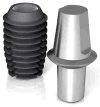Delayed versus immediate loading of implants: survival analysis and risk factors for dental implant failure
- PMID: 18201604
- PMCID: PMC5560427
- DOI: 10.1016/j.joms.2007.09.012
Delayed versus immediate loading of implants: survival analysis and risk factors for dental implant failure
Abstract
Purpose: The purpose of this study was to estimate 1-year survival for delayed versus immediately loaded implants and identify risk factors for implant failure.
Materials and methods: This was a retrospective cohort study, consisting of a sample of subjects who had greater than or equal to 1 Bicon dental implant (Bicon, Boston, MA) placed over a 13-year period. The primary predictor variable was method of implant loading: delayed (3 to 6 months after placement) or immediately after insertion. Secondary predictor variables were classified as demographic, anatomic, implant/abutment, and reconstructive. The outcome variable was implant failure, defined as removal of the implant, and was recorded as months of survival. Descriptive, Kaplan-Meier, and univariate Cox proportional hazards statistics were computed. Univariate associations with P <or= .15 and biologically relevant variables (eg, age, gender) were included in a marginal multiple Cox regression model. In the multiple model, a P value of <or= .05 was considered statistically significant.
Results: The study sample consisted of 677 subjects who had 2,349 delayed-loaded dental implants and 178 patients who had 477 immediate-loaded implants. The unadjusted 1-year survival estimates for the delayed and immediate loading groups were 95.5% and 90.3%, respectively (P < .01). In the marginal multiple Cox regression model, immediate loading, current tobacco use, maxillary implants, and shorter implants were associated with failure (P <or= .05).
Conclusion: In this study, implants loaded immediately were 2.7 times (after adjusting) more likely to fail at 1 year compared with delayed-loaded implants.
Figures
Similar articles
-
Immediate loading of splinted locking-taper implants: 1-year survival estimates and risk factors for failure.Int J Oral Maxillofac Implants. 2008 Jan-Feb;23(1):105-10. Int J Oral Maxillofac Implants. 2008. PMID: 18416418
-
Immediate versus conventional loading of post-extraction implants in the edentulous jaws.Clin Implant Dent Relat Res. 2014 Dec;16(6):926-35. doi: 10.1111/cid.12055. Epub 2013 Mar 18. Clin Implant Dent Relat Res. 2014. PMID: 23506353
-
Immediate loading of post-extractive versus delayed placed single implants in the anterior maxilla: outcome of a pragmatic multicenter randomised controlled trial 1-year after loading.Eur J Oral Implantol. 2015 Winter;8(4):347-58. Eur J Oral Implantol. 2015. PMID: 26669545 Clinical Trial.
-
New-design dental implants: a 1-year prospective clinical study of 344 consecutively placed implants comparing immediate loading versus delayed loading and flapless versus full-thickness flap.Int J Oral Maxillofac Implants. 2014 Jan-Feb;29(1):e14-21. doi: 10.11607/jomi.te37. Int J Oral Maxillofac Implants. 2014. PMID: 24451883
-
Early and immediately restored and loaded dental implants for single-tooth and partial-arch applications.Int J Oral Maxillofac Implants. 2004;19 Suppl:92-102. Int J Oral Maxillofac Implants. 2004. PMID: 15635949 Review.
Cited by
-
Comparative evaluation of two types of immediately loaded implants using biomechanical and histomorphometric tests: an animal case study.ISRN Dent. 2012;2012:328945. doi: 10.5402/2012/328945. Epub 2012 Jul 18. ISRN Dent. 2012. PMID: 22852091 Free PMC article.
-
Dental Implant Survival in Vascularized Bone Flaps: A Systematic Review and Meta-Analysis.Plast Reconstr Surg. 2020 Sep;146(3):637-648. doi: 10.1097/PRS.0000000000007077. Plast Reconstr Surg. 2020. PMID: 32459736 Free PMC article.
-
Indications and contraindications of dental implants in medically compromised patients: update.Med Oral Patol Oral Cir Bucal. 2014 Sep 1;19(5):e483-9. doi: 10.4317/medoral.19565. Med Oral Patol Oral Cir Bucal. 2014. PMID: 24608222 Free PMC article. Review.
-
Comparative evaluation among laser-treated, machined, and sandblasted/acid-etched implant surfaces: an in vivo histologic analysis on sheep.Int J Implant Dent. 2020 Feb 19;6(1):7. doi: 10.1186/s40729-019-0204-4. Int J Implant Dent. 2020. PMID: 32072319 Free PMC article.
-
Results of immediate loading for implant restoration in partially edentulous patients: a 6-month preliminary prospective study using SinusQuick™ EB implant system.J Adv Prosthodont. 2009 Nov;1(3):136-9. doi: 10.4047/jap.2009.1.3.136. Epub 2009 Nov 30. J Adv Prosthodont. 2009. PMID: 21165269 Free PMC article.
References
-
- Branemark PI, Hansson BO, Adell R, Breine U, Lindstrom J, Hallen O, Ohman A. Osseointegrated implants in the treatment of the edentulous jaw. Experience from a 10-year period. Scand J Plast Reconstr Surg Suppl. 1977;16:1–132. - PubMed
-
- Calvo MP, Muller E, Garg AK. Immediate loading of titanium hexed screw-type implants in the edentulous patient: case report. Implant Dent. 2000;9(4):351–7. - PubMed
-
- Yoo RH, Chuang SK, Erakat MS, Weed M, Dodson TB. Changes in crestal bone levels for immediately loaded implants. Int J Oral Maxillofac Implants. 2006 Mar-Apr;21(2):253–61. - PubMed
-
- Albrektsson T, Branemark PI, Hansson HA, Lindstrom J. Osseointegrated titanium implants. Requirements for ensuring a long-lasting, direct bone-to-implant anchorage in man. Acta Orthop Scand. 1981;52(2):155–70. - PubMed
-
- Albrektsson T, Hansson T, Lekholm U. Osseointegrated dental implants. Dent Clin North Am. 1986;30:151–174. - PubMed
Publication types
MeSH terms
Substances
Grants and funding
LinkOut - more resources
Full Text Sources


